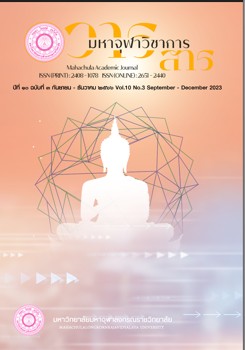Guidelines for the Educational Management Model of Phrapariyattidhamma on Pali Section based on the Seven Suitables (Sappāyas) of Wat Paknam School Phasicharoen in Bangkok
Main Article Content
Abstract
The research had three objectives as follows: (1) to study the format of Buddhist Pali education provision of the country and Wat Paknam, (2) to study the education provision according to the principles of Seven Sappaya in the scriptures of Buddhist Theravada, and (3) to analyze the principles of Buddhist Pali education provision according to the principles of Seven Sappaya of Wat Paknam, Phasicharoen District, Bangkok Metopolitan. The research was the qualitative method by means of documentary research and field research. The key informants were administrators and assistant abbots of Wat Paknam, scholars, teachers and students from other monasteries, totaling 12. The research tool was the in-dept interview with descriptive analytics.
The research study found that (1) The format of Buddhist Pali education provision in four aspects in the Ratnakosin period has been well and properly managed in each period even though some imperfect as follows: As for curriculum in the period of Rama 1, Tripitaka was used as the text for three-year studies with one Pitaka for one year. As for teaching, there were very few personnel and for studying, the study was only provided in the capital, scarcely unavailable in rural areas. In the period of Rama 2, some formats of education provision were changed. For instance, as for curriculum the text of Tripitaka was changed to Atthakatha and Dika which has been used upto now. As for Wat Paknam”s Buddhist Pali education provision, the format has been following the monastic regulations, some perfect, some imperfect. (2) As for the Buddhist education provision according to the principles of Seven Sappaya, though the purpose of Sappaya’s principles is the Insight Development, if applied to the process of the Buddhist education provision, these principles are of importance in the education provision for monks and novices in order to make convenient and easy because the education is the development according to Trisikkha. (3) The five aspects of the format of Buddhist Pali education provision according to the principles of Seven Sappaya of Wat Paknam, Phasicharoen District, Bangkok Metropolitan are the following: (1) As for curriculum and texts, they should be improved. (2) As for administrators, teachers and students, the personnel’s potentials should be developed. (3) As for administrators, teachers and students, the students should be developed. (4) As for services, the services and sufficient budget should be supported. (5) As for locations, the locations should be developed, the buildings and classrooms, even small, should be tidy and clean and the education must have quality, standard and update.
Article Details

This work is licensed under a Creative Commons Attribution-NonCommercial-NoDerivatives 4.0 International License.
References
พระเฉลิมชาติ ชาติวโร (อิทธะรงค์). “ศึกษาวิเคราะห์การพัฒนาการศึกษาของคณะสงฆ์ไทย”. วิทยานิพนธ์พุทธศาสตรมหาบัณฑิต สาขาวิชาพระพุทธศาสนาส. บัณฑิตวิทยาลัย: มหาวิทยาลัยมหาจุฬาลงกรณราชวิทยาลัย, ๒๕๕๑.
พระเทพปริยัติวงศ์ (พาย ภทฺทโก). ประชุมคณะครูสอนปริยัติธรรมสำนักเรียนวัดปากน้ำ ครั้งที่ ๒. กรุงเทพมหานคร: สำนักเรียนวัดปากน้ำ (อัดสำเนา), ๒๕๖๑.
พระพรหมคุณาภรณ์ (ป. อ. ปยุตฺโต). พจนานุกรมพุทธศาสตร์ ฉบับประมวลธรรม. พิมพ์ครั้งที่ ๒๓. กรุงเทพมหานคร: มหาวิทยาลัยมหาจุฬาลงกรณราชวิทยาลัย, ๒๕๕๘.
พระพุทธโฆสาจารย์. คัมภีร์วิสุทธิมรรค. แปลและเรียบเรียงโดย สมเด็จพระพุฒาจารย์(อาจ อาสภมหาเถร). พิมพ์ครั้งที่ ๖. Taiwan: The Corporate body of the Buddha Educational Foundation, ๒๕๔๘.
พระพรชาติ พุทธสโร (ภาคพรม). “การศึกษาหลักสัปปายะที่เกื้อกูลต่อการปฏิบัติธรรมของสำนักปฏิบัติธรรมในเขตจังหวัดสุรินทร์”. วิทยานิพนธ์พุทธศาสตรมหาบัณฑิต สาขาวิชาพระพุทธศาสนา. บัณฑิตวิทยาลัย: มหาวิทยาลัยมหาจุฬาลงกรณราชวิทยาลัย, ๒๕๖๑.
พระมหาขวัญชัย ปุตฺตวิเสโส (บุตรวิเศษ). “ทิศทางการพัฒนาผู้สำเร็จการศึกษาเปรียญธรรม ๙ ประโยคในทศวรรษหน้า”. วิทยานิพนธ์พุทธศาสตรมหาบัณฑิต สาขาวิชาพระพุทธศาสนา. บัณฑิตวิทยาลัย: มหาวิทยาลัยมหาจุฬาลงกรณราชวิทยาลัย, ๒๕๖๑.
พระมหาบุญชัย ปภสฺสรเมธี (จูแวน). “ศึกษาสภาพการดาเนินงานการจัดการศึกษาพระปริยัติธรรมแผนกบาลีของสำนักเรียนในเขตกรุงเทพมหานคร”. วิทยานิพนธ์การศึกษามหาบัณฑิต สาขาวิชาการบริหารการศึกษา. กรุงเทพมหานคร: มหาวิทยาลัยศรีนครินทรวิโรฒ, ๒๕๕๑.
พระมหาทองดี ปญฺญาวชิโร. ประวัติความเป็นมาสำนักเรียนวัดปากน้ำ. นครปฐม: หจก.สตาร์กรุ๊ป (1994), ๒๕๔๙.
พระมหาวรัญญู วรญฺญู (สอนชุน). วิสัยทัศน์การศึกษาพระมงคลเทพมุนี. กรุงเทพมหานคร: บริษัท เอกพิมพ์ไท จำกัด, ๒๕๕๙.
มหาวิทยาลัยมหาจุฬาลงกรณราชวิทยาลัย. พระไตรปิฎกภาษาไทย ฉบับมหาจุฬาลงกรณราชวิทยาลัย. กรุงเทพมหานคร: โรงพิมพ์มหาจุฬาลงกรณราชวิทยาลัย, ๒๕๓๙.
มหาวิทยาลัยมหามกุฏราชวิทยาลัย. พระไตรปิฎกพร้อมอรรถกถา แปล ชุด ๙๑ เล่ม. กรุงเทพมหานคร: โรงพิมพ์มหามกุฏราชวิทยาลัย, ๒๕๓๔.
สานุ มหัทธนาดุล และสีวลี ตระกูลวิเชียร. “ชีววิทยาเชิงพุทธ : ระบบความสัมพันธ์ของชีวิตและสิ่งแวดล้อม และการสร้างปัจจัยเกื้อกูลต่อการพัฒนาชีวิตตามหลักสัปปายะ”. รายงานวิจัย. ทุนอุดหนุนการวิจัยจากสำนักงานคณะกรรมการวิจัยแห่งชาติ (วช.) ปี พ.ศ. ๒๕๕๗. สถาบันวิจัยพุทธศาสตร์: มหาวิทยาลัยมหาจุฬาลงกรณราชวิทยาลัย, ๒๕๕๗.
Sanu Mahatthanadull. “Modern Buddhism, Education, and the State in Thailand and Japan” Sanu Mahatthanadull, “Modern Buddhism, Education, and the State in Thailand and Japan”, Commemorative Book, The Second Tohoku Conference on Global Japanese Studies, Tohoku University, Sendai, Japan (December 14-15, 2019): 1-21.


